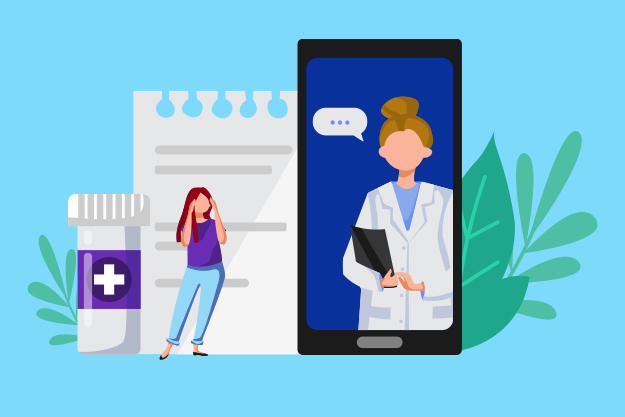Why Employees Need A Seamless Benefits Experience
What makes it so easy to use a service like Amazon? There are a number of reasons: you can access product offerings in one place, filter for cost...
Connected Navigation Platform
Guiding to high-value care
Behavioral Health
Foster a mentally healthy workplace
EAP
Supporting holistic wellbeing
Virtual MSK Care
Reimagining musculoskeletal care
Virtual Primary Care
Powered by smart navigation
Surgery Centers of Excellence
Best-in-class surgical outcomes
Virtual Urgent Care
Immediate care, any hour of the day
Chronic Care
A new approach to chronic care
Integrations
Flexible to any strategy

In the air or on the road— many of today’s workers are often on-the-go. In the last decade, the smartphone has given employees constant access to their company’s internal systems and has changed the workplace forever. Direct access to emails, video conferencing, and internal office apps have created instant communication. Companies like WeWork have even given employers the ability to virtualize their offices. Whether it’s a jet-setting programmer or a sales team that is prospecting new potential clients, a mobile workforce can be found in nearly every industry. And as companies cut ties with their offices in the wake of the COVID-19 pandemic, that change is likely to accelerate.
A A 202 Gallup report found that 33% of Americans are now always working remotely, and 25% are sometimes working remotely; about two-thirds of remote workers want to continue to work that way.
Having a mobile workforce unleashes productivity by being located closer to where the employee is most productive and saving them commute time. It also translates into less office expenses for the employer. According to a report by The Economist, employees who identified their organization “pioneers” in the use of mobile technologies scored 16 percent higher for productivity than others who described their organization’s use of mobile technology as “bad.” If a company wants to succeed, embracing a mobile-first outlook including employee benefits is the way to go.
Just as their frequent flier miles, hotel reservations and restaurant recommendations are moving to app-based platforms, employee benefits and healthcare access is also shifting to accommodate the needs of mobile workforces. Mobile employees are often not in one place all week, meaning that scheduling even the most basic doctor’s check-up can pose some difficulty. That is why mobile healthcare access on the move is essential. Employees will love having mobile access to their benefits and healthcare providers. It is an easy way to find in-network and online doctors at any given location. With more employees joining the mobile workforce, providing mobile benefits access to employees is beneficial for employees health and for employers it also means less sick days.
Most people’s primary care physician is near their home for the sake of convenience. If a worker isn’t near home for most of the week, it will be difficult for them to access a consistent group of providers on a regular basis. Therefore, when they inevitably need to seek care while in another part of town or city, they may be at a complete loss of which provider to choose. They’ll be unfamiliar with the doctors in that location, and there is no comprehensive online resource to give them trustworthy recommendations. Without a reliable source of help, they will be prone to the many pitfalls of selecting the wrong doctor.
A healthcare guidance platform can save the day through the expertly crafted provider and facility recommendations that can you can access through a mobile app. These platforms enlist healthcare concierges to research and recommend physicians, dentists and other healthcare providers for needed services based on in-network status, quality, cost and availability information. Mobile workers in an unfamiliar state can become more informed about the top nearby provider options than even a local resident who doesn’t have the service. Essentially, these systems help workers who have been uprooted from their home base location to be knowledgeable about the healthcare offerings around them no matter where they happen to be.
Some mobile workforce members, however, don’t even have the luxury of being on the ground to visit a doctor in person. Frequent-flyers or road warriors will need telemedicine that enables them to access online physicians wherever and whenever they need care. Through telemedicine, workers can consult a doctor over the phone, via video, or through chat 24/7. A flight attendant with a digestive issue might typically try to ignore the problem because they know they won’t have the ability to see a doctor anytime soon. With access to telemedicine, within minutes the flight attendant can open an app and chat with a board-certified physician who can help them diagnose the issue and give them medical recommendations that improve their health right away, they can even get a prescription written that they can pick up at an airport pharmacy.
On-the-go workers have a busy lifestyle. They have tight schedules with back-to-back calls, client meetings or connecting flights to get to. The lifestyle of traveling workers calls for a quick and efficient solution to health needs that fits into their schedule. With healthcare guidance, employees save hours upon hours of precious time with advice at every step of the process. Healthcare concierges will research to find the right provider and so much more, so members don’t have to. When applicable, the user will be guided to an online doctor consultation so that they don’t waste unnecessary time and money in waiting rooms or commuting to the doctor’s office. Users also have the option to chat with doctors on-demand, to answer quick questions. They will even manage the user’s insurance coverage to inform them of the cost of treatment and ensure that they recommend providers that are in-network. On top of that, a healthcare concierge will even schedule appointments for the member. If they ever lose track of their scheduled appointment they can send a simple text message to find it. All that’s left for the user to spend time on is receiving high-quality care and advice from their medical provider.
A significant obstacle faced by the mobile workforce is finding providers that are in-network and eligible for coverage under their insurance plan while on the road. People are unclear about what types of services and doctors are included in their coverage, to begin with, and it is even more daunting to ask these questions in an unfamiliar state. Luckily, healthcare guidance platforms act as an all-in-one benefits platform, so all of a worker’s insurance coverage status and details are available in one app. Healthcare concierges are experts in navigating the insurance world and will only deliver provider recommendations that are in-network. Mobile workforce members will no longer have to be careful on the road due to narrower networks that vary state-by-state but can rest assured that they are being led to the best providers their insurance coverage has to offer.
Since the mobile workforce is not grounded, they can’t rely on the large packets of benefits info that arrives in their mailboxes. They need to be able to access benefits information conveniently through the cloud and healthcare guidance platforms offer just this. Not only do users have access to an online benefits wallet containing essential information from all of their insurance carriers, but they can also track their real-time deductible spend, HSA/HRA/FSA/401k account balances, and coverage levels in an easy to understand, simple format that they carry with them wherever they are. Understanding benefits has never been so painless and convenient.
Healthcare guidance platforms will even go the extra mile to communicate relevant messages to employees through smartphone push notifications and chats. They will remind users of gaps in care and unused services and provide ongoing education about their plan benefits. For traveling employees who have a lot on their mind, these consistent reminders are invaluable and help them take maximum advantage of all the benefits provided by their employer.
A prime example of valuable information that healthcare guidance platforms will communicate to users is prescription savings. They will complete a prescription savings review to find savings on a user’s medication and lead them to the best place to visit for their Rx needs. The review will match the member’s plan formulary with potential saving opportunities and complete research on nine key areas, such as therapeutic alternatives, manufacturer coupons and generic alternatives. Even in an unfamiliar city, workers will be able to know precisely where to pick up their medications and they will be notified when savings are available. That way users can minimize their efforts while maximizing savings and convenience.
All in all, mobile workforces have unique constraints on their ability to access medical care and modern app and cloud-based platforms must be leveraged to help meet their health needs as employees. It only makes sense that an on-the-go worker needs on-the-go benefits access. A healthcare guidance platform might be the perfect remedy to a traveling worker’s car sickness.

What makes it so easy to use a service like Amazon? There are a number of reasons: you can access product offerings in one place, filter for cost...

On average, organizations spend over $15,000 per year on each employee experiencing mental health issues. Employers are constantly searching for...

During the pandemic, we heard a lot about the harmful effects of delayed care. Employees who were afraid to see their doctors in person skipped...